Government of Scanonia
| Government of the Kingdom of Scanonia | |
|---|---|
| Konungariket Skåniens regering | |
 Lesser coat of arms of Scanonia | |
| Overview | |
| Established | 1970 |
| State | |
| Leader | Prime Minister (Statsminister) |
| Appointed by | Prime Minister appointed by the Riksdag, other members appointed by the Prime Minister |
| Main organ | Cabinet (Statsråd) |
| Responsible to | Riksdag |
| Website | www.regeringen.sk |
The Government of the Kingdom of Scanonia (Scanonian: Konungariket Skåniens regering), known under its short name in the Basic Laws of Scanonia and in vernacular as Regeringen ("the Government") , is the national cabinet and executive authority of Scanonia.
History
Organisation
The Government of Scanonia operates as a collegial body with collective ministerial responsibility to the Scanonian Riksdag. It consists of the head of the government, the Prime Minister, appointed by the Speaker of the Riksdag following a vote of absolute majority of members, and cabinet ministers, appointed and dismissed by the sole discretion of the Prime Minister. Prime Minister and its ministers form a Cabinet (Statsråd), which is responsible for its actions to the Riksdag.
After the 1970 constitutional reforms and amendments to the Instrument of the Government, a constitutional document of Scanonia, the Scanonian monarch has lost all nominal executive powers, whilst upholding solely ceremonial title, whilst providing the Government with sole executive powers.
Role and scope
Main responsibilities and duties of the Government are set in the Instrument of the Government (Scanonian: Regeringsformen), one of the Fundamental Laws of Scanonia. After the constitutional crisis and tensions with the Fyngarian Socialist Republic, new Instrument of the Government was issued in 1970, which reformed the political system in Scanonia. Sole executive powers were vested in the Government, while the Scanonian monarch retained ceremonial title. The Instrument of the Government also brought all state administrative authorities under the Government, creating an unique feature of the Scanonian constitutional system; Cabinet ministers do not bear individual ministerial responsibility, nor they can personally interfere with the day to day operations of the governmental agencies subordinate of their ministerial departments, rather, governmental agencies report directly to the Government as a collective body, which in turn report to the Riksdag.
Cabinet
Formation and dismissal
Following the general elections, Speaker of the Riksdag holds talks with leaders of the parliamentary groups with representation in the Riksdag. After the talks, the Speaker proposes a candidate for Prime Minister to the Riksdag chamber for confirmation voting. An absolute majority of the votes (150 seats) is required in order to confirm the nomination, otherwise the Speaker has 3 days to propose a new candidate. When the Prime Minister's nomination is confirmed, he appoints cabinet ministers and presents them to the Riksdag during his exposé in a special council held in front of the Monarch in the Kristianstad palace.
The Riksdag may initiate vote of no confidence against any cabinet minister individually. If vote of no confidence is cast against a Prime Minister, the entire government is rejected and new general elections are called for within a month.